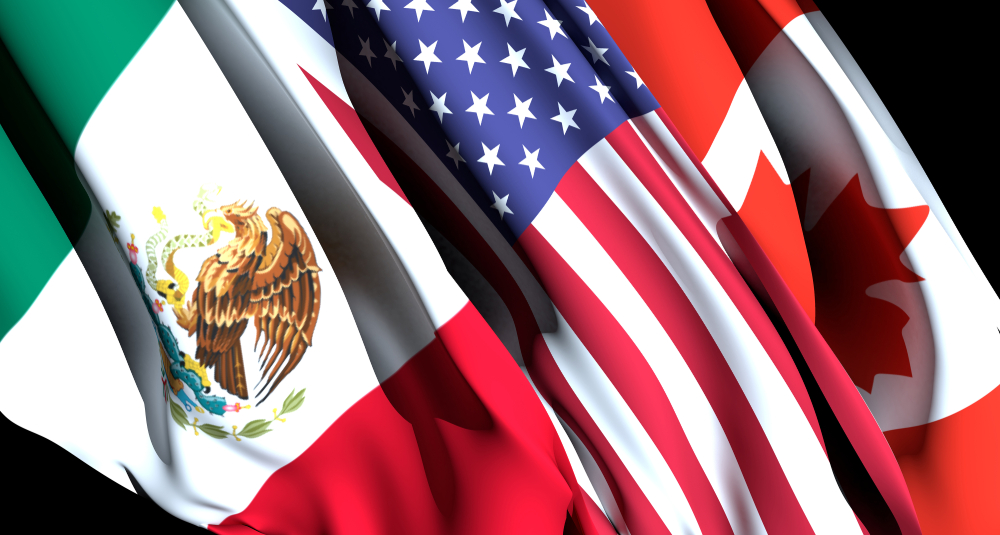After several years of discussion and negotiation, the U.S.-Mexico-Canada Agreement (USMCA) officially replaced the North American Free Trade Agreement (NAFTA) on July 1, 2020. The new free trade agreement brings with it a host of changes that will impact manufacturers across numerous industries, both those already operating in Mexico and those considering manufacturing here for its nearshoring benefits.
USMCA brings a range of changes, from dramatic adjustments to entire supply chains, to broadening the requirements for documentation. These changes impact virtually everyone in manufacturing at some level—and carry steep penalties for noncompliance. As a result, it is critical that every company in the manufacturing and related space takes a look at their processes today. Working with an expert in import and export administration or tailored advisory support services is one way to ensure your company does not overlook a step that could bring a steep fine.
The 90-day grace period
The most notable changes to USMCA are the rule of origin changes that will require automakers to use 75% North American content, compared to 62.5% under NAFTA. Of that content, 40%-45% must soon come from a facility where workers earn at least $16 per hour. The U.S. has published a notice in the Federal Register with details on how it will calculate the latter requirement, an indication that details are still emerging on how to comply with the agreement.
Although automotive manufacturers—who are perhaps hardest hit by the more stringent rule of origin clause—have three to four years to fully comply with these new requirements, there are initial requirements that went into effect on July 1, 2020. So long as manufacturers show “good faith efforts” to comply, there is a 90-day grace period for implementation.
It’s also important to note that the automotive industry is far from the only sector impacted. Textile and apparel producers also have new rules of origin content requirements. Electronics manufacturing industry representatives note that the deal will strengthen trade between the three countries based on new provisions in the agreement. And the medical device manufacturing industry sees the potential for reducing duplicate regulations, providing less red tape for manufacturers in Mexico’s robust medical device industry. Virtually every manufacturer exporting products from Mexico to the United States will be impacted.
Fortunately, U.S. Customs and Border Protection (CBP) has published “interim guidance” to help manufacturers navigate the first six months of the new requirements’ implementation. CBP notes that through December 31, 2020, it will focus on supporting efforts to comply with USMCA requirements, including providing webinars and other outreach efforts to educate manufacturers on the new requirements. The agency also notes it “will show restraint” in enforcement during this transition period.
Steps to take today to ensure USMCA compliance
Given the brief timeframe between the release of the final version of the USMCA and its implementation date, it’s important to review all steps once again to ensure compliance. Steps to take now include the following:
- Don’t assume that because your products were tariff-free in the past that they will remain so today. USMCA covers a more expansive range of products than NAFTA did. Check the documentation carefully.
- Get educated on the procedures and steps to take to comply with the new methodology. CBP has a list of product-oriented webinars it will present to ensure you meet requirements for your sector.
- Ensure your product’s raw materials meet the rules of origin requirements. Consider reaching out to downstream suppliers to ensure they, too, are prepared to comply with USMCA.
- Create a process for providing certification of origin. There is no prescribed format for this certification, but it must contain all data elements laid out in Annex 5-A of USMCA.
- Develop a process for maintaining records and documentation on the origin of your materials and finished products, as well as compliance with shipment provisions. CBP notes that some of these materials might include bills of materials with data about each material or certifications or affidavits from the producer of each originating material stating the country of manufacture. You will need to maintain these documents for a minimum of five years, and be able to provide them upon request.
- Work with your legal team or other advisory consultants to review applicable requirements and create a thorough plan for implementation.
Prevent penalties by working with a compliance consultant
USMCA carries great potential for strengthening trade between Mexico, the United States, and Canada. Still, it will take time for all parties to become accustomed to working within the new requirements. Unfortunately, the agreement is bringing with it a steep learning curve. Although the implementation date had been pushed back from June to July 1, many manufacturers were hoping for a January 2021 deadline to allow a more extended transition period for meeting the new requirements.
After October 1, USMCA’s strict penalties will be fully implemented. Experts note that the new agreement carries stricter penalties than NAFTA, impacting even small suppliers. Penalties may include retroactive tariffs and additional duties. To reduce the potential for an unpleasant surprise when implementation is fully in effect, it will pay to have a complete plan for compliance in place today.
Fortunately, you don’t have to do this work alone. Manufacturers working under the umbrella of a shelter service company like Tetakawi have access to supporting resources that simplify regulatory compliance challenges. To best prepare for USMCA, reach out to Tetakawi today.
Subscribe
Sign up and stay informed with tips, updates, and best practices for manufacturing in Mexico.





